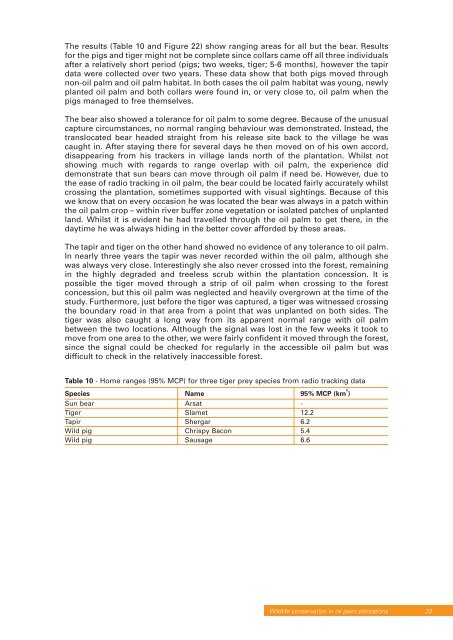The conservation of tigers and other wildlife in oil palm plantations
The conservation of tigers and other wildlife in oil palm plantations
The conservation of tigers and other wildlife in oil palm plantations
You also want an ePaper? Increase the reach of your titles
YUMPU automatically turns print PDFs into web optimized ePapers that Google loves.
<strong>The</strong> results (Table 10 <strong>and</strong> Figure 22) show rang<strong>in</strong>g areas for all but the bear. Results<br />
for the pigs <strong>and</strong> tiger might not be complete s<strong>in</strong>ce collars came <strong>of</strong>f all three <strong>in</strong>dividuals<br />
after a relatively short period (pigs; two weeks, tiger; 5-6 months), however the tapir<br />
data were collected over two years. <strong>The</strong>se data show that both pigs moved through<br />
non-<strong>oil</strong> <strong>palm</strong> <strong>and</strong> <strong>oil</strong> <strong>palm</strong> habitat. In both cases the <strong>oil</strong> <strong>palm</strong> habitat was young, newly<br />
planted <strong>oil</strong> <strong>palm</strong> <strong>and</strong> both collars were found <strong>in</strong>, or very close to, <strong>oil</strong> <strong>palm</strong> when the<br />
pigs managed to free themselves.<br />
<strong>The</strong> bear also showed a tolerance for <strong>oil</strong> <strong>palm</strong> to some degree. Because <strong>of</strong> the unusual<br />
capture circumstances, no normal rang<strong>in</strong>g behaviour was demonstrated. Instead, the<br />
translocated bear headed straight from his release site back to the village he was<br />
caught <strong>in</strong>. After stay<strong>in</strong>g there for several days he then moved on <strong>of</strong> his own accord,<br />
disappear<strong>in</strong>g from his trackers <strong>in</strong> village l<strong>and</strong>s north <strong>of</strong> the plantation. Whilst not<br />
show<strong>in</strong>g much with regards to range overlap with <strong>oil</strong> <strong>palm</strong>, the experience did<br />
demonstrate that sun bears can move through <strong>oil</strong> <strong>palm</strong> if need be. However, due to<br />
the ease <strong>of</strong> radio track<strong>in</strong>g <strong>in</strong> <strong>oil</strong> <strong>palm</strong>, the bear could be located fairly accurately whilst<br />
cross<strong>in</strong>g the plantation, sometimes supported with visual sight<strong>in</strong>gs. Because <strong>of</strong> this<br />
we know that on every occasion he was located the bear was always <strong>in</strong> a patch with<strong>in</strong><br />
the <strong>oil</strong> <strong>palm</strong> crop – with<strong>in</strong> river buffer zone vegetation or isolated patches <strong>of</strong> unplanted<br />
l<strong>and</strong>. Whilst it is evident he had travelled through the <strong>oil</strong> <strong>palm</strong> to get there, <strong>in</strong> the<br />
daytime he was always hid<strong>in</strong>g <strong>in</strong> the better cover afforded by these areas.<br />
<strong>The</strong> tapir <strong>and</strong> tiger on the <strong>other</strong> h<strong>and</strong> showed no evidence <strong>of</strong> any tolerance to <strong>oil</strong> <strong>palm</strong>.<br />
In nearly three years the tapir was never recorded with<strong>in</strong> the <strong>oil</strong> <strong>palm</strong>, although she<br />
was always very close. Interest<strong>in</strong>gly she also never crossed <strong>in</strong>to the forest, rema<strong>in</strong><strong>in</strong>g<br />
<strong>in</strong> the highly degraded <strong>and</strong> treeless scrub with<strong>in</strong> the plantation concession. It is<br />
possible the tiger moved through a strip <strong>of</strong> <strong>oil</strong> <strong>palm</strong> when cross<strong>in</strong>g to the forest<br />
concession, but this <strong>oil</strong> <strong>palm</strong> was neglected <strong>and</strong> heavily overgrown at the time <strong>of</strong> the<br />
study. Furthermore, just before the tiger was captured, a tiger was witnessed cross<strong>in</strong>g<br />
the boundary road <strong>in</strong> that area from a po<strong>in</strong>t that was unplanted on both sides. <strong>The</strong><br />
tiger was also caught a long way from its apparent normal range with <strong>oil</strong> <strong>palm</strong><br />
between the two locations. Although the signal was lost <strong>in</strong> the few weeks it took to<br />
move from one area to the <strong>other</strong>, we were fairly confident it moved through the forest,<br />
s<strong>in</strong>ce the signal could be checked for regularly <strong>in</strong> the accessible <strong>oil</strong> <strong>palm</strong> but was<br />
difficult to check <strong>in</strong> the relatively <strong>in</strong>accessible forest.<br />
Table 10 - Home ranges (95% MCP) for three tiger prey species from radio track<strong>in</strong>g data<br />
Species Name 95% MCP (km 2 )<br />
Sun bear Arsat -<br />
Tiger Slamet 12.2<br />
Tapir Shergar 6.2<br />
Wild pig Chrispy Bacon 5.4<br />
Wild pig Sausage 6.6<br />
Wildlife <strong>conservation</strong> <strong>in</strong> <strong>oil</strong> <strong>palm</strong> <strong>plantations</strong> 33

















